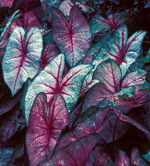Tropicals Pack a Punch With Foliage, Color, Size
go.ncsu.edu/readext?234386
en Español / em Português
El inglés es el idioma de control de esta página. En la medida en que haya algún conflicto entre la traducción al inglés y la traducción, el inglés prevalece.
Al hacer clic en el enlace de traducción se activa un servicio de traducción gratuito para convertir la página al español. Al igual que con cualquier traducción por Internet, la conversión no es sensible al contexto y puede que no traduzca el texto en su significado original. NC State Extension no garantiza la exactitud del texto traducido. Por favor, tenga en cuenta que algunas aplicaciones y/o servicios pueden no funcionar como se espera cuando se traducen.
Português
Inglês é o idioma de controle desta página. Na medida que haja algum conflito entre o texto original em Inglês e a tradução, o Inglês prevalece.
Ao clicar no link de tradução, um serviço gratuito de tradução será ativado para converter a página para o Português. Como em qualquer tradução pela internet, a conversão não é sensivel ao contexto e pode não ocorrer a tradução para o significado orginal. O serviço de Extensão da Carolina do Norte (NC State Extension) não garante a exatidão do texto traduzido. Por favor, observe que algumas funções ou serviços podem não funcionar como esperado após a tradução.
English
English is the controlling language of this page. To the extent there is any conflict between the English text and the translation, English controls.
Clicking on the translation link activates a free translation service to convert the page to Spanish. As with any Internet translation, the conversion is not context-sensitive and may not translate the text to its original meaning. NC State Extension does not guarantee the accuracy of the translated text. Please note that some applications and/or services may not function as expected when translated.
Collapse ▲
Hedychium ‘Lemon Beauty’
Robert E. Lyons ©
Tropicals, many of which can be considered tender perennials, are plants that seem to shout, “Look at me!” Gardeners find it hard to resist the dramatic punch and exotic interest that these plants add through foliage, texture, color, size and flowers. Some of these plants cannot survive our winters and must be protected, or replanted each year. However, many surprisingly live through Zone 7 winters. Douglas Ruhren, horticulturist at the Daniel Stowe Botanical Garden, which features many such plants, spoke recently at the JC Raulston Arboretum. Here are some of his recommendations for “hardy tender” perennials in Zone 7 or warmer.
Bananas lend an exotic element and fill large spaces. Consider Musa basjoo,Japanese fiber banana, Musa velutina, pink velvet banana or Musa acuminata ‘Zebrina’. The blood banana ‘Bordelon’ is also a good choice for North Carolina.
Ginger lilies are making a comeback as more people rediscover their graceful touch. Hedychium ‘Daniel Weeks’ and ‘Peach Delight’ are good performers. Other excellent choices are ‘C.P. Raffle,’ ‘Dr. Moy’ and ‘Moy Giant’. The tall, late-blooming ‘Elizabeth’ is also lovely.
Elephant ears provide an old-fashioned touch. Look for Alocasia x ‘Portadora’,Colocasia esculenta ‘Burgundy Stem’, ‘Illustris’ and ‘Black Magic’.

Caladium
Robert E. Lyons ©
Cannas add punctuation with their green, red or striped foliage and intense tropical-looking flowers. Try Canna‘Striata’ and ‘Phaison’. A tried and true standby is the caladium. Look for the fancy-leaved varieties such as ‘White Christmas’, ‘Carolyn Wharton’, ‘Red Ruffles’ and ‘Miss Muffet’.
A stunning display of tropical plants can be enjoyed at the Entry Garden of the JC Raulston Arboretum. Located at the entrance to the main parking lot, the kaleidoscope of color and texture delights the senses until the first killing frost, usually in mid to late October.
David Barkley


